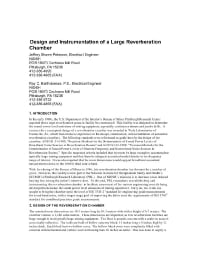Mining Publication: Design and Instrumentation of a Large Reverberation Chamber
Original creation date: June 2003
Authors: JS Peterson, RC Bartholomae
NIOSHTIC2 Number: 20023410
NOISE-CON 2003. Ames, IA: Institute of Noise Control Engineering of the USA, 2003 Jun; :1-8
In the early 1980s, the U.S. Department of the Interior's Bureau of Mines Pittsburgh Research Center required that a large reverberation acoustic facility be constructed. This facility was designed to determine the sound power level emissions of mining equipment, especially continuous miners and jumbo drills. A contract for a conceptual design of a reverberation chamber was awarded to Wyle Laboratories of Huntsville, AL, which had extensive experience in the design, construction, and accreditation of acoustical reverberation chambers. The following standards were referenced as guidelines for the design of the chamber: ANSI S1.31-1980, "Precision Methods for the Determination of Sound Power Levels of Broadband Noise Sources in Reverberation Rooms" and ANSI S1.32-1980: "Precision Methods for the Determination of Sound Power Levels of Discrete-Frequency and Narrowband Noise Sources in Reverberation Rooms." Specific requested criteria included that the room be large enough to accommodate typically large mining equipment and that there be adequate acoustical modal density in the frequency range of interest. It was also required that the room dimensions would support broadband acoustical measurements down to the 100 Hz third octave band.
With the closing of the Bureau of Mines in 1996, this reverberation chamber lay dormant for a number of years. However, this facility is now part of the National Institute for Occupational Safety and Health's (NIOSH's) Pittsburgh Research Laboratory (PRL). One of NIOSH's missions is to decrease noise induced hearing loss among the nation's mineworkers. To this end, PRL researchers are refurbishing and instrumenting this reverberation chamber to facilitate assessment of the various engineering controls being developed to decrease the sound power level emissions of mining equipment. Early on, this work has sought to bring the chamber up to the level of ISO 3743-21 standard for engineering grade measurements for broad-band noise, with a longer range goal of improving the lab to meet the requirements of ISO 37412 standard for broadband precision grade measurements.

NIOSHTIC2 Number: 20023410
NOISE-CON 2003. Ames, IA: Institute of Noise Control Engineering of the USA, 2003 Jun; :1-8
- Assessment and Evaluation of Noise Controls on Roof Bolting Equipment and a Method for Predicting Sound Pressure Levels in Underground Coal Mining
- Emergency Escape and Refuge Alternatives
- How to Operate a Refuge Chamber: A Quick Start Guide
- Passive Fiber Optic System for Locating, Tracking, and Communicating with Personnel in Coal Mines
- Recommendations for Refuge Chamber Operations Training
- Refuge Alternatives in Underground Coal Mines
- Technology News 537 - NIOSH Develops New Mine Refuge Chamber Training
- Underground Mine Refuge Chamber Expectations Training: Program Development and Evaluation
- When Do You Take Refuge? Decisionmaking During Mine Emergency Escape
- Work-Principle Model for Predicting Toxic Fumes of Nonideal Explosives